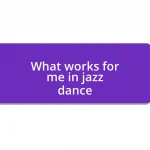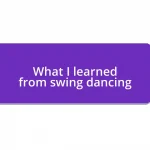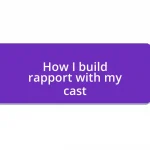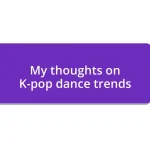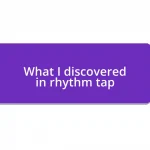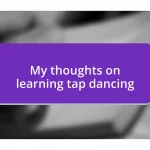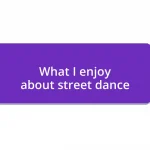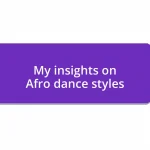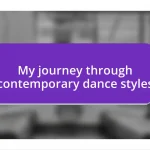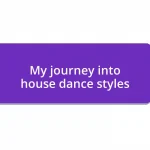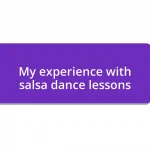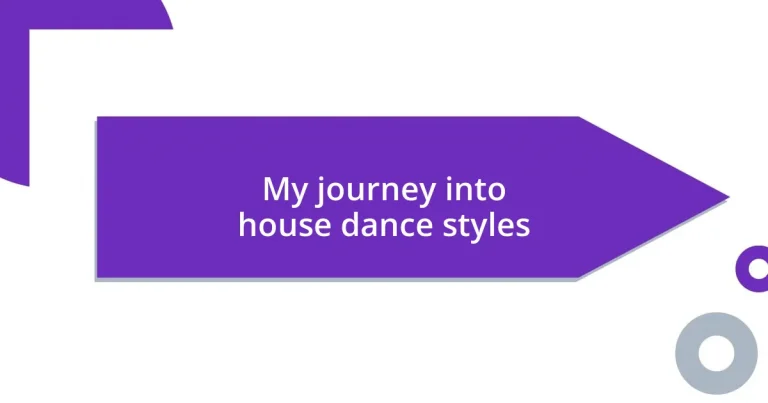Key takeaways:
- House dance offers a mix of individual expression and community connection through the rhythm and energy of the music.
- The key elements include swift footwork, improvisation, and a strong connection to house music.
- Different substyles such as “jacking,” “footwork,” and “lofting” showcase the diversity and unique expression within house dance.
- Practicing with intention, observing experienced dancers, and engaging in online communities significantly enhance learning and skill development.
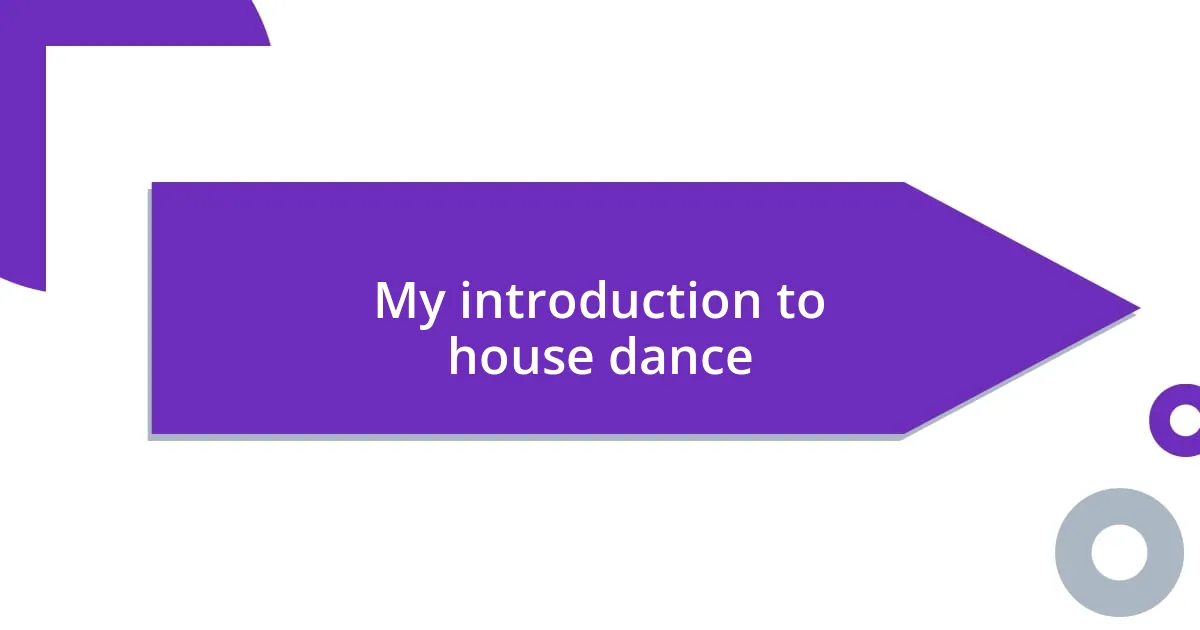
My introduction to house dance
The first time I stepped into a house dance class, I was filled with a mix of excitement and nervousness. I remember thinking, “Can I really keep up with everyone?” As the beat dropped and the energy shifted in the room, that feeling quickly faded; I became entranced by the rhythm and the fluid movements around me, each dancer expressing their individuality.
During my early days, the vibrant atmosphere of the underground dance events left a lasting impression on me. I can still recall the pulsing lights reflecting off the smiling faces, creating a sense of community where everyone felt connected by the same passion. It made me wonder—how can something like music and dance bring so many different people together? The answer was clear: house dance was not just a style; it was a shared experience.
After some time, I started to feel more comfortable with the fundamentals of house dance—the swift footwork and the intricate body isolations. I remember nailing my first set of shuffling steps and how liberating it felt to finally express myself. It clicked for me then: house dance was not just about the moves; it was about the freedom to be yourself on the dance floor, and that realization ignited a lasting love affair with this art form.
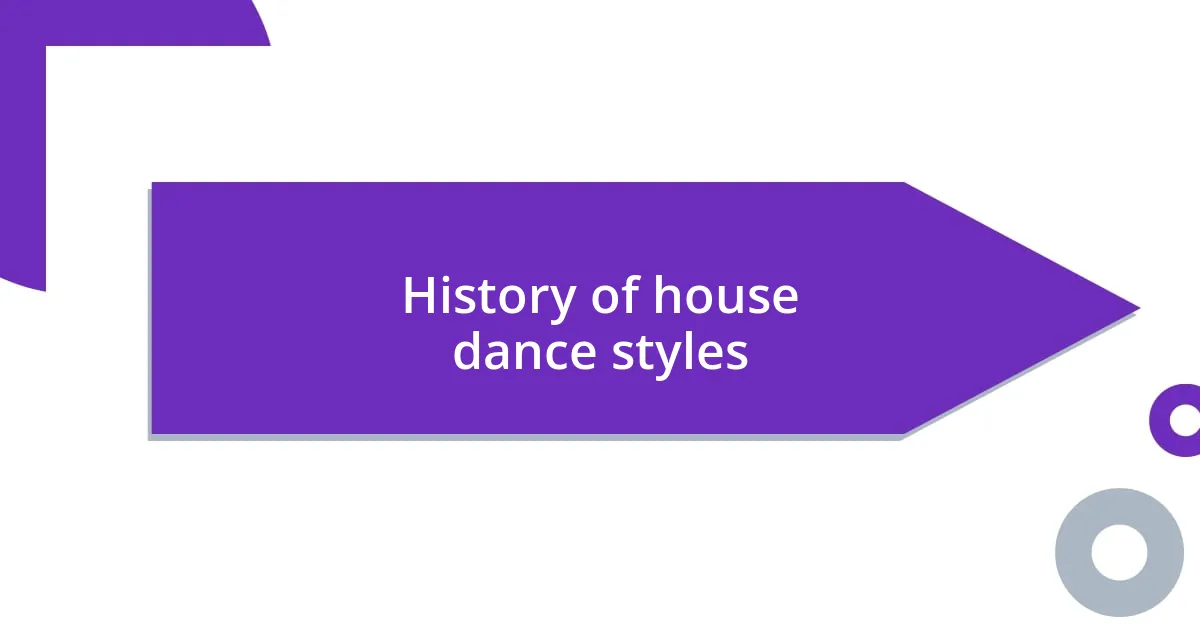
History of house dance styles
House dance styles emerged in the early 1980s in Chicago, evolving from the vibrant club scene influenced by disco music. I remember hearing stories of dancers at places like the Warehouse, where the sounds of Frankie Knuckles and Larry Heard filled the air. The way they described the energy of those nights felt almost magical, as if each movement was a new brushstroke on a living canvas, expressing emotions that transcended words.
- House dance often incorporates elements from various styles, including jazz, hip-hop, and even African dance.
- The syncopated footwork and fluid body movements truly reflect the infectious beats of house music.
- Dancers often express themselves through improvisation, making each performance unique and personal.
- Over the years, house dance has spread globally, influencing countless artists and giving rise to substyles like “jacking” and “footwork”.
In my journey, I’ve had moments where the rhythm of the music intertwined with my heart, and suddenly, I felt connected to those early Chicago dancers. It’s profound to think that I’m part of a lineage that celebrates individuality through this ever-evolving art form.
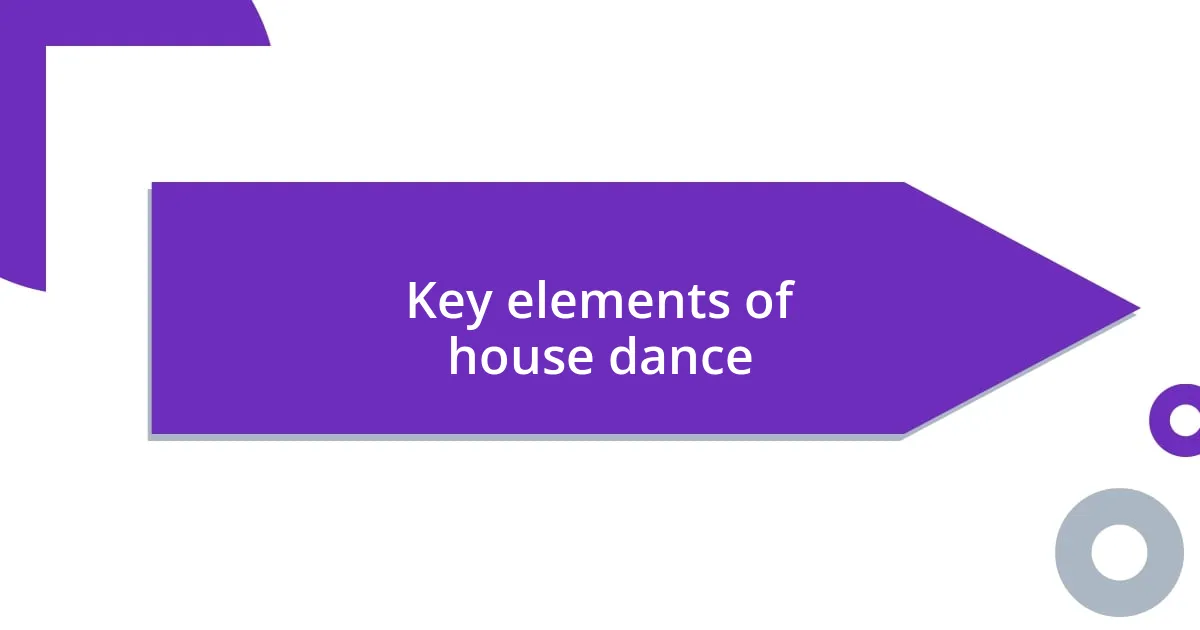
Key elements of house dance
The key elements of house dance are what truly define its essence. One of the most critical aspects is the characteristic footwork, showcasing a mix of swift shuffles, slides, and intricate patterns that create a mesmerizing flow. I still remember the thrill of learning these steps; each movement felt like a conversation with the floor, pulling me deeper into the rhythm of the music. The way my feet could glide and shuffle in sync with the beat made me realize how deeply intertwined the dance was with the music itself.
Another fundamental component is the ability to improvise. I recall moments on the dance floor when the music would take an unexpected turn, and I had to adapt instantly. Those moments were thrilling and challenging. It nurtured a spontaneous expression that was uniquely mine, allowing me to stitch my feelings into the fabric of the performance. Each dance session felt like a jam session, where my body responded to the vibes around me, creating a distinctive experience every time.
Lastly, the connection to the house music is paramount. The deep bass lines and soulful melodies in house tracks resonate with the emotions dancers convey. As I moved, I often thought about how the energy in the room could shift with just a single beat drop. It’s this relationship that fuels creativity in house dance, making every performance a reflection of the music, the audience, and the dancer’s individuality.
| Element | Description |
|---|---|
| Footwork | Characteristic swift shuffles and intricate patterns that create fluid motion. |
| Improvisation | Ability to express oneself spontaneously, responding to music’s energy. |
| Connection to music | The rhythm and emotion of house music shape and inspire the dance experience. |
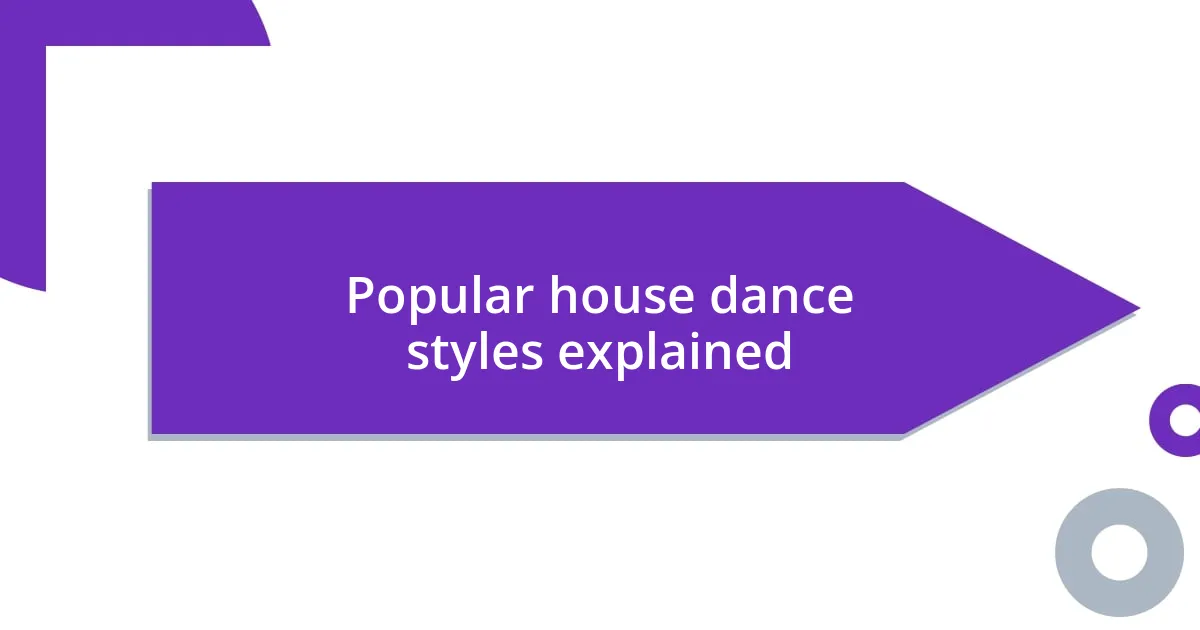
Popular house dance styles explained
When exploring popular house dance styles, it’s fascinating to see how unique each substyle can be. For instance, “jacking” is all about those sharp, rhythmic movements that arise from your core, almost like your body is naturally responding to the beat. I remember the first time I tried jacking; it felt liberating as if every thrust was an invitation to the beat itself, encouraging me to let go and just move. Have you ever felt that kind of energy pulling at you in the middle of a beat drop?
On the other hand, “footwork” delves into intricate and speedy steps that almost tell a story of their own. There’s a certain joy in mastering the quick shifts and turns; every rehearsal taught me a new way to express my personality through movement. I often find myself thinking about how engaging footwork truly feels—like a dance-off with the floor where every misstep turns into an opportunity to create something unexpectedly beautiful.
Then there’s “lofting,” which incorporates fluid, continuous movements that give a sense of weightlessness. I vividly recall dancing with a group where we all embraced this style. As we glided seamlessly across the floor, I felt like we were painting a collective masterpiece, each individual adding their own stroke. It’s moments like these that highlight how house dance can foster a sense of community, transforming a simple dance session into a shared celebration of movement and connection. Have you ever experienced that unique camaraderie on the dance floor? It truly deepens the joy of dancing!
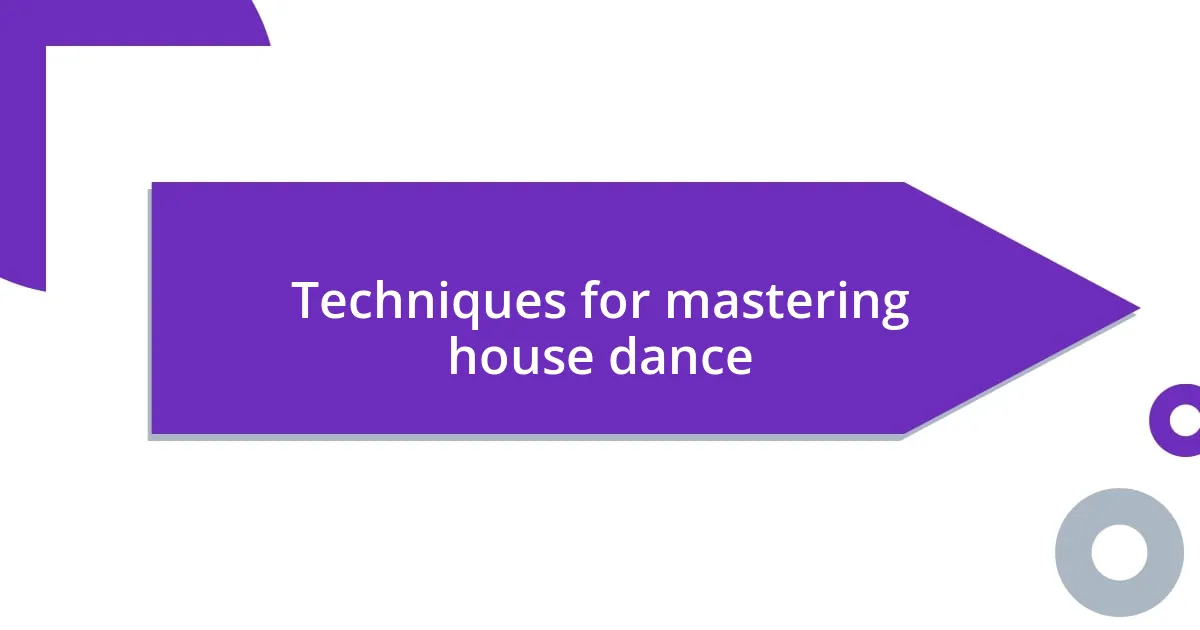
Techniques for mastering house dance
To truly master house dance, practicing rhythmic foot patterns is essential. I remember spending hours in front of my mirror, breaking down each movement slowly. This deliberate practice helped me internalize the rhythms, allowing my body to naturally sync with the beat. Have you tried isolating just one step and focusing on it until you feel every nuance?
Another technique that significantly enhanced my dancing was dancing with intention. Every time I hit the floor, I made a conscious effort to connect my movements to the music’s energy. I recall a night at a local club when I let the bass guide my body; it felt like I was having an intimate conversation with the music. This connection transformed my approach to each session, making every movement deliberate and meaningful.
Finally, I can’t stress enough the importance of watching and learning from others. I often found inspiration by observing seasoned dancers, noting how their body language told stories. It was during one memorable workshop that I learned the power of feedback—after performing, the instructor’s insights opened my eyes to new ways of interpreting the movements. Have you ever found that one moment of learning that drastically changed your perspective? For me, that was it.
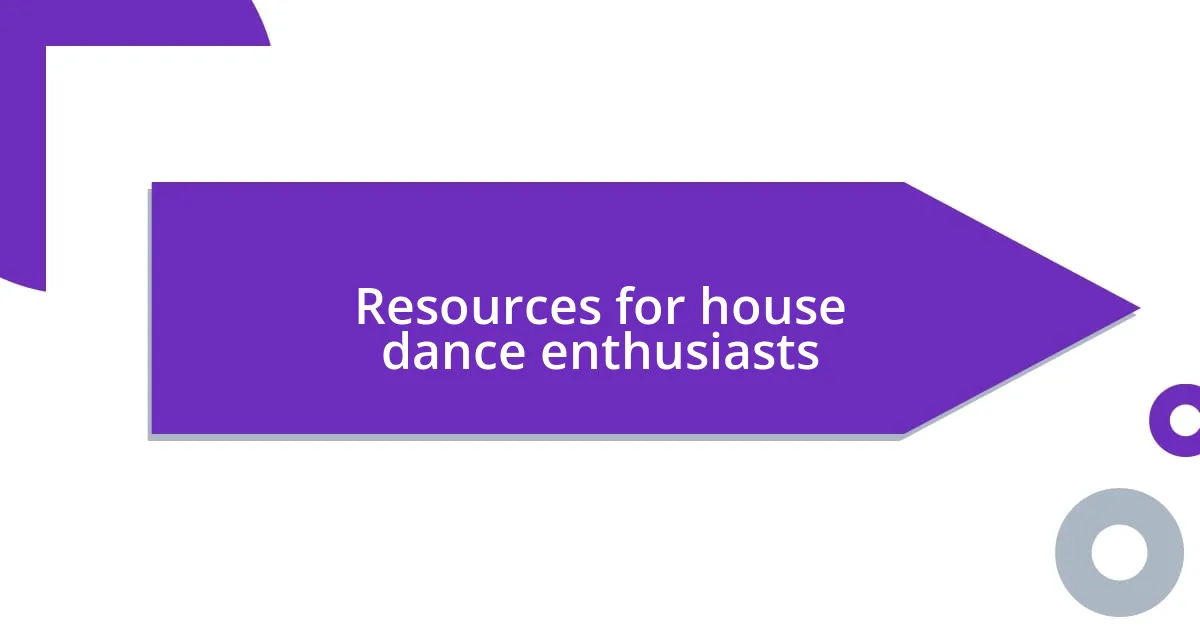
Resources for house dance enthusiasts
Finding the right resources to enhance your house dance journey can be incredibly rewarding. I still remember the thrill of discovering online platforms dedicated to house dance tutorials. Websites like YouTube and DancePlug became my go-to spots. Watching videos from experienced dancers not only inspired me but also introduced me to varied styles and techniques that I could try out at home. Have you ever stumbled upon a video that made you jump up and dance right away?
Aside from videos, joining online dance communities has been a game-changer for me. Engaging with fellow house dance enthusiasts on social media platforms or forums allows for exchanging tips, experiences, and even feedback on performances. I recall a moment when a group of us collaborated on an online challenge; the camaraderie and shared excitement felt like a mini dance party, even through screens! Do you find that connecting with others enhances your motivation to keep growing?
And let’s not overlook the value of local workshops and classes. Attending a session with local instructors was pivotal for my growth. I vividly remember my first workshop where I learned a new combination; the energy in the room was electric, and it felt like we were all vibing together to the same rhythm. These face-to-face experiences offer instant feedback and a chance to refine your skills. Have you had the opportunity to explore local resources that could elevate your dance journey? It’s amazing how much these interactions can transform your practice.
